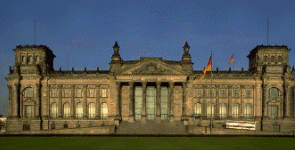 |

|
 |
| By Jack Nichols Doubling its number of marchers since last year, Berlin's gay and lesbian pride parade estimates put last Saturday's participation levels at a record 250,000. In a nation where pioneer activist Dr. Magnus Hirschfeld founded the world's first gay rights group in 1898 and where Hirschfeld himself was attacked in 1933 while the extraordinary center he founded, Berlin's Institute for Sexual Science, was burned to the ground by right-wing fanatics, ninety festive floats were counted. Before the huge crowds dispersed a minute of silence was observed in memory of citizens struck down by the AIDS visrus. Far-right fanatics of the present day were ridiculed during Rome's annual pride march, numbering 3,000, and following public demands by Dianfranco and Daniela Fini, heads of the pro-fascist National Alliance, that homosexuals be excluded from teaching and sports professions. After walking through central parts of Rome, the marchers enjoyed an open air concert. In the United States, urban centers held their annual parades across the length and breadth of the nation, continuing a growing tradition that first began in Manhattan twenty-eight years ago, followed quickly that same summer by the Christopher Street West parade in Los Angeles. Describing early gay pride parades as "mostly beer trucks and drag queens" the late Chicago gay activist and journalist ,Jon-Henri Damski, a gay activist and writer, told Chicago Tribune columnist Mary Schmich that these cruder productions had been the norm before the city's pride parades began turning into "Ellenized" TV events ,"as slick as a Cub production." This year's Chicago parade featured a 26-by-50-foot American flag, weighing 80 pounds and carried by 40 members of the Gay, Lesbian and Bisexual Veterans of America/Chicago. Heads of activist organizations as well as local political figures were included as special guests: business tycoons and pioneering celebrities like David Kopay, a former professional football star who came out in the 1970s. The Windy City's parade started at 2 p.m. on Halstead Street and Belmont Avenue, after which it proceeded north on Halstead to Broadway, south to Diversy Parkway, then east to Cannon Drive where a 4 p.m. rally in Lincoln Park ensued. In the June 26 edition of The Los Angeles Times, Professor Robert Dawidoff explained that gay pride parades are not about flaunting anything, but about celebrating freedom. "We take pride in our history," he said, listing many of the greatest gay and lesbian luminaries from Sappho to Walt Whitman. Dawidoff, who teaches history at Claremont Graduate University, also wrote that gays and lesbians take pride in their sexuality. "Gays are routinely criticized," he said, "for flaunting private things in public. But American culture is not about our sex lives but about the relentless selling and instruction of heterosexuals in what is supposed to be their natural inclination." Dawidoff says that many gays make a public point of sexuality "because secrecy is not a substitute for constitutionally protected privacy, which we do not yet have." "We also take pride in our survival," explained the history professor. "Born into families that do not welcome us, into communities, religions, and ethnic groups that disdain us, with a culture that still has little place for us, we must make our own ways. We should and do take pride in having survived the thousand petty harassments and reminders of a special status we neither seek nor merit." |
